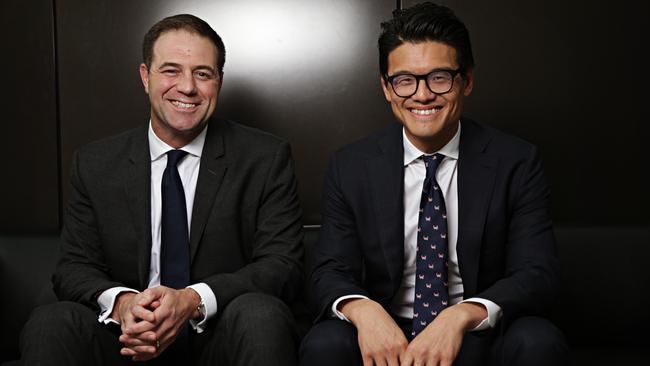How Macquarie Group plans to make money from climate change
Our biggest investment bank is in the thick of it when it comes to innovative renewable energy projects

It’s a large-scale thermal waste-to-energy project — the nation’s first — which will eventually cut as much carbon from the environment as achieved by taking 85,000 cars off the road. It’s a project, based in Kwinana, WA, that has involved local councils and state and federal governments. The facility, now under construction, is expected to open next year and process about 400,000 tonnes per year of household, commercial and industrial rubbish to generate clean energy. And it’s a project that may never have happened without the Macquarie Group deal-makers who have shepherded the investment funds central to the $700m project. The deal includes debt funding of $400m of which the Clean Energy Finance Corporation tipped in up to $90m.
The WA plant is just one of several global projects designed to turn waste into energy that are backed by the $587.5bn asset management and investment banking giant — keen to capitalise on predictions that investment in renewables will balloon to more than $US4 trillion ($6 trillion) globally in the next decade.
It’s a big bet for Macquarie, one it has been working on steadily for years. But Macquarie Capital’s global co-head Daniel Wong says, that while the firm has been working in renewable energy for about 15 years, it is now a “core part” of the infrastructure and capital business. “We’ve been connecting those opportunities all around the world,” Wong says. “This is about connecting the long-term capital with the projects and capital investment … that’s what our customers want.”
Says Macquarie Capital’s Australia co-head John Pickhaver: “We are in the thick of all of those new and emerging technologies as they develop, some of them are old technologies applied in new places, some are new technologies that are developing rapidly as the cost of old technologies continues to come down.”
An indication of Macquarie’s focus is its hiring: it now recruits a range of specialists beyond finance in the energy and infrastructure sphere. They include construction experts, engineers, geoscientists, meteorologists and data scientists.
As governments and large companies around the world look to reduce carbon emissions and rebuild and modernise infrastructure, Macquarie is pouncing on what it considers a significant commercial opportunity.
“The big picture is that if we can be relevant to these capital markets and our customers there, it’s just simply good business,” Wong adds. “Increasingly our customers want to buy energy, want to buy clean green energy because they are not waiting for countries to go net zero.”
While converting waste to energy is an attractive investment because power is readily available and not intermittent, Wong highlights Macquarie’s strong interest in offshore and floating offshore wind projects, the evolution of solar power and tapping into hydrogen energy.
Macquarie — and its business units — have vast investments and exposures in renewable energy including a stake in East Anglia ONE offshore wind farm in the UK’s North Sea, providing debt to a portfolio of Spanish solar farms, and backing offshore wind projects in Taiwan. Last year, the company’s Green Investment Group acquired the US solar development and energy storage unit of Enel Green Power subsidiary Tradewind Energy.
Macquarie’s largest step up in the sector came when it acquired the UK government’s Green Bank in 2017 — which became Green Investment Group — in a deal that included committing to lead £3bn ($6bn) of investment in green energy over three years. Wong is chairman of GIG.
Macquarie is visible as a financial adviser, provider of capital and more recently has made a bigger push into earlier stages of projects, including as a development partner.
But moving into projects at a development stage also comes with much higher levels of risk, as that involves procuring equipment, construction and managing output to a set timetable.
The Avertas Energy Kwinana waste-to-energy plant is a co-development between Macquarie and Phoenix Energy and is owned by Macquarie and the Dutch Infrastructure Fund. It will export baseload renewable electricity to the grid each year, sufficient to power more than 50,000 homes.
Macquarie also has an advisory and financing role in Snowy 2.0 the major expansion of hydro-electric generation and storage capability at NSW’s Snowy Hydro. The group’s chief executive Shemara Wikramanayake has been vocal on the “inexorable march” to renewable energy technologies: she is a founding member of the Climate Finance Leadership Initiative, formed at the request of the UN. The company’s first-half accounts showed its advisory and principal investments division had more than 250 renewable projects under development or construction as at September 30 and total balance sheet investments in green energy of $1.3bn.
Macquarie’s Pickhaver says investors are on the lookout for opportunities in the renewable sector, despite policymakers still working through how the transition would occur with support from the existing grid. “We are not alone in Australia in working through that energy transition, various markets around the world are at various different stages of working through that,” he says.
In Europe, Wong says, regulators and governments are trying to reinforce the energy grid to deal with renewable energy capacity. This includes options like building batteries or more closely managing demand and the way energy is used.
In a February strategy briefing, Macquarie executives gave investors and analysts a rare taste of future projects linked to emissions reduction and renewable energy.
They included looking at capturing carbon in the production of barrels of crude oil and storing it elsewhere and an aircraft project which would see a plane, due to the materials used and the way it was built, be carbon neutral on delivery.

